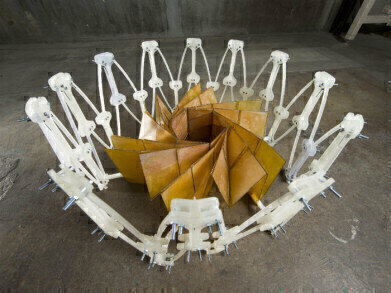Green Energy
How to Make Origami Crane Solar Panels
Oct 31 2014
Brian Trease began experimenting with origami during a high school exchange to Japan. “I’d be folding subway ticket stubs and baseball game lineups,” Trease explains. “There’s a picture of me in McDonalds in the city of Kobe holding a big origami crane that I had just folded [out of a hamburger wrapper]. Now it’s come full circle—I’m doing this as my career.”
NASA calls
Today, Trease is a mechanical engineer at NASA’s Jet Propulsion Laboratory, dreaming up new ways of transporting cumbersome objects through space as lightly and swiftly as possible. Several years ago, NASA started working on a new project involving solar panel technology - since solar panels are large and heavy, Trease was tasked with making them more compact and transportable. It was then that he recalled his interest in origami.
Traditionally, origami involves folding paper. (In Japanese, “ori” means “folding” and “gami” means “paper”.) Origami masters take a single sheet of paper and create sculptural forms by folding. Trease, on the other hand, applied the same principal to metals and plastics, attempting to create an expandable structure, which could be transported and deployed with minimal fuss.
Hannaflex
Working alongside origami master Robert Lang, as well as a number of students and engineers, Trease developed a foldable solar panel prototype, which could expand from 8.9 feet in diameter to 82 feet. Trease and his colleagues called the technique they used “hannaflex”. Their creation resembles a compacted flower, which “blooms” outwards, forming a flat, circular solar panel. “This is just begging to be deployed with centrifugal force,” says Trease. “We could have it on spacecraft where we just spin it and that force allows the panels to deploy out to their position.”
Although Trease’s origami solar panel prototype is far from the finished article and there remain plenty of problems to work through, NASA is taking the origami idea seriously. “With one general technique we’ve open the door to deploy much larger versions of all of these,” says Trease.
In the coming years, Trease faces a number of challenges, however. Firstly, Trease and his colleagues must find a material capable of withstanding repeated stress. Secondly, once the solar panel has been transported, who is going to unfold it – or how is it going to unfold itself? (Trease’s “centrifugal force” theory is untested.)
Issues aside, NASA is currently work-shopping origami techniques, having invited some of the world’s finest paper folders to brainstorm more origami-inspired ideas. Trease asserts: “The public has to know [origami is] more than just paper folding, it’s more than just this children’s art or something you do in school. There’s a lot of artistic expertise in understanding the folds, but it’s heavily backed up by math and engineering.”
NASA Research Continues
Recently, NASA, alongside Jason West from the University of North Carolina, have also completed a new study in which the worst areas of air pollution throughout the world have been highlighted. You can found out which country is the biggest perpetrator in this article: NASA Map Highlights World's Worst Air Pollution Offenders.
Image Credit: NASA
Events
Apr 24 2024 Sao Paulo, Brasil
May 05 2024 Seville, Spain
May 13 2024 Munich, Germany
May 23 2024 Beijing, China
May 23 2024 Beijing, China














